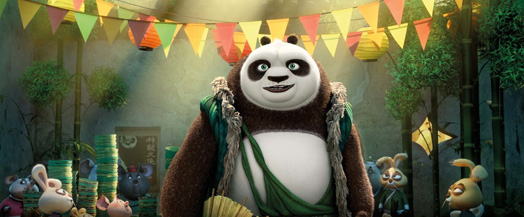Movie Review: Kung Fu Panda 3
By Ben Gruchow
February 9, 2016
BoxOfficeProphets.com

All of which renders the actual movie itself a little incidental; after all, if DreamWorks were looking to wow us with a qualitatively bar-setting chapter of the Kung Fu Panda franchise, they would’ve rolled the dice on one of those other release dates, yes? Yet, the movie is not a failure, or even a near-miss; it’s certifiably pleasant and reasonably clear-minded about its premise. As a bonus, it’s positively gorgeous to look at. And, having experienced the carnival of souls that was Norm of the North just a few weeks ago, there is no universe in which I am not cognizant of the merits of basic competency and respectability in an animated film.
I hasten to mention that the movie, which again stars Jack Black as the titular panda and a cavalcade of supporting cast members with varying degrees of recognizability, is not without some sizable problems - chiefly that it’s repeating an undemanding storytelling template with very little to mark it as particularly fresh or called-for, but the movie also suffers from an indistinct antagonist and a surprising amount of attenuation to both its cast and its subplots. Between this and the original film (I have not seen the second), it comes off the lesser.
Po (Black) has reached a plateau of his development as a martial artist. He is now tasked with becoming the instructor of the Furious Five: Tigress (Angelina Jolie); Crane (David Cross); Mantis (Seth Rogen); Viper (Lucy Liu); and Monkey (Jackie Chan), and his lack of confidence exhibits a tendency to bleed over and actually become a limiter. This comes at a bad time, because the immortal Kai (J.K. Simmons), a warrior trapped in a spirit dimension, has finally collected enough stolen chi - a type of metaphysical, innate energy - to escape back to the mortal realm. The specifics of what he plans to do once there are a little fuzzy, but I don’t think we need to pretend that endgame logic is much of a priority here. At any rate, Kai starts whatever endgame he has by stealing the chi of all mortal Kung Fu masters.
Reading back over that word salad of a plot description makes one reflect on how paint-by-numbers the whole enterprise is on the level of storytelling… but then, the first film was that way, too. Nor is there much witticism on display; Black’s priority in embodying Po seems to be making the grade on geniality rather than any particular intelligence or discovery. The supporting characters don’t really succeed on any developmental front other than being supporting. And the subplots have a way of announcing themselves from their first shot; Po is adopted, and the reveal of his biological father in this film (played by Bryan Cranston) assures us that there will be jealousies that threaten character relationships.
This is where we reflect on the fact that implication of threat is not quite the same thing as actual threat, because there’s never really the sense that anyone’s actually going to be permanently affected by the adverse developments in Kung Fu Panda 3, even when those developments are conducted by Kai; the visual design of the movie’s antagonist conveys a nice shrewdness and anger, and Simmons’ habit (in genre films, anyway) of sounding like he’s growling his lines from around a mouthful of scenery translates altogether well to a project of this type, but it’s still a surprisingly low-risk feeling we get from the scenario.
What counters this? The energy level helps; the Kung Fu Panda franchise is pretty good at hitting the sweet spot where there’s a lot of light and color and movement going on, but not so much that it becomes exhausting. The first film was especially good at this, considering the volume of high-speed martial-arts sequences and the plasticity of the character design; how easy could it have been to make a viper do kung fu in a way that wasn’t a morass of visual confusion? Directors Jennifer Yuh Nelson and Alessandro Carloni let this movie benefit from a clear-eyed approach to action; there’s perhaps more quick cutting here than there was before, but we still get moments during high-intensity sequences where motion and balance align themselves and give us moments that are nearly poetic in their construction.
I confess that I don’t see much of a future for the Kung Fu Panda franchise after this installment; the feeling we get as the movie winds up to its inevitable showdown between Kai and Po (and his entire family; one of the subplots we encounter here is the implication that Po’s training may only be truly completed from his clan’s remote mountain village; the father, Li Shan, has returned to Po’s life to guide him through this development, and it’s another of those instances where we can see the general shape of the outcome almost before it has asserted itself as an existing thing) is one of slight windedness, as though the 95-minute running time was just a little more than the material has the energy for. This is a fun movie, though, silly and rather superficial, but not at all stupid or condescending. I look forward to seeing what the filmmakers do next, with more challenging material.